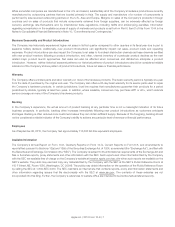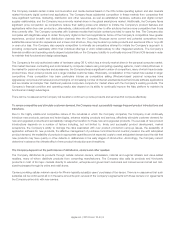Apple 2015 Annual Report Download - page 19
Download and view the complete annual report
Please find page 19 of the 2015 Apple annual report below. You can navigate through the pages in the report by either clicking on the pages listed below, or by using the keyword search tool below to find specific information within the annual report.The Company is exposed to credit risk on its trade accounts receivable, vendor non-trade receivables and prepayments related to
long-term supply agreements, and this risk is heightened during periods when economic conditions worsen.
The Company distributes its products through third-party cellular network carriers, wholesalers, retailers and value-added resellers. The
Company also sells its products directly to small and mid-sized businesses and education, enterprise and government customers. A
substantial majority of the Company’s outstanding trade receivables are not covered by collateral, third-party financing arrangements or
credit insurance. The Company’s exposure to credit and collectability risk on its trade receivables is higher in certain international markets
and its ability to mitigate such risks may be limited. The Company also has unsecured vendor non-trade receivables resulting from
purchases of components by outsourcing partners and other vendors that manufacture sub-assemblies or assemble final products for the
Company. In addition, the Company has made prepayments associated with long-term supply agreements to secure supply of inventory
components. As of September 26, 2015, a significant portion of the Company’s trade receivables was concentrated within cellular
network carriers, and its vendor non-trade receivables and prepayments related to long-term supply agreements were concentrated
among a few individual vendors located primarily in Asia. While the Company has procedures to monitor and limit exposure to credit risk
on its trade and vendor non-trade receivables, as well as long-term prepayments, there can be no assurance such procedures will
effectively limit its credit risk and avoid losses.
The Company could be subject to changes in its tax rates, the adoption of new U.S. or international tax legislation or exposure to
additional tax liabilities.
The Company is subject to taxes in the U.S. and numerous foreign jurisdictions, including Ireland, where a number of the Company’s
subsidiaries are organized. Due to economic and political conditions, tax rates in various jurisdictions may be subject to significant change.
The Company’s effective tax rates could be affected by changes in the mix of earnings in countries with differing statutory tax rates,
changes in the valuation of deferred tax assets and liabilities, or changes in tax laws or their interpretation, including in the U.S. and Ireland.
For example, in June 2014, the European Commission opened a formal investigation of Ireland to examine whether decisions by the tax
authorities with regard to the corporate income tax to be paid by two of the Company’s Irish subsidiaries comply with European Union
rules on state aid. If the European Commission were to conclude against Ireland, it could require Ireland to recover from the Company
past taxes covering a period of up to 10 years reflective of the disallowed state aid, and such amount could be material.
The Company is also subject to the examination of its tax returns and other tax matters by the Internal Revenue Service and other tax
authorities and governmental bodies. The Company regularly assesses the likelihood of an adverse outcome resulting from these
examinations to determine the adequacy of its provision for taxes. There can be no assurance as to the outcome of these examinations. If
the Company’s effective tax rates were to increase, particularly in the U.S. or Ireland, or if the ultimate determination of the Company’s
taxes owed is for an amount in excess of amounts previously accrued, the Company’s financial condition, operating results and cash
flows could be adversely affected.
Apple Inc. | 2015 Form 10-K | 17
























